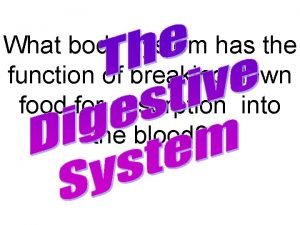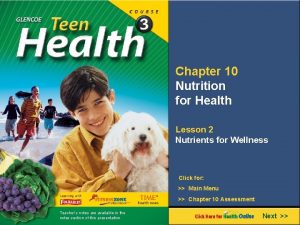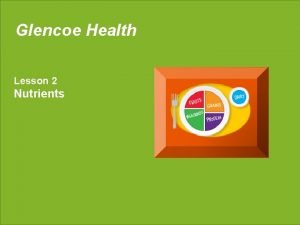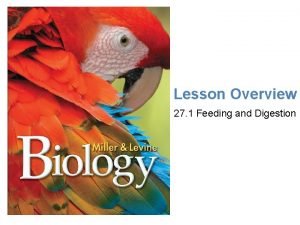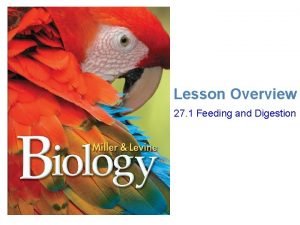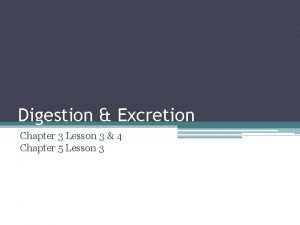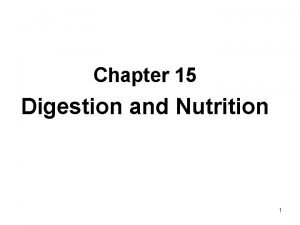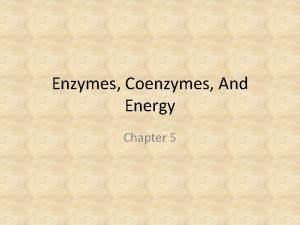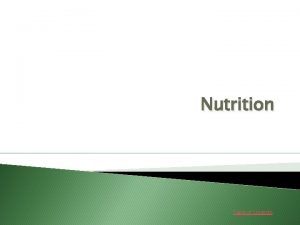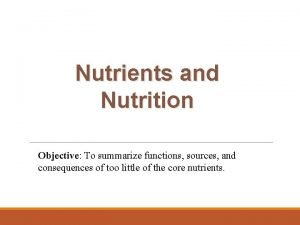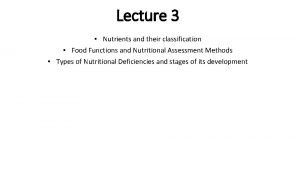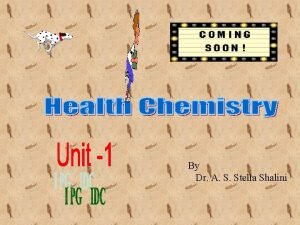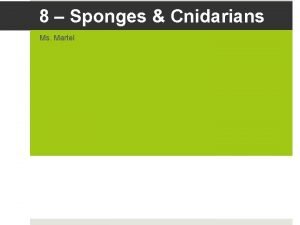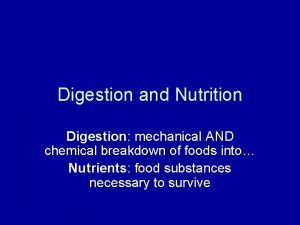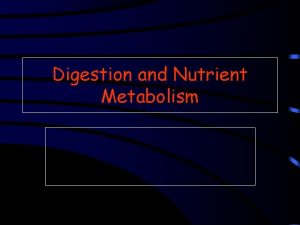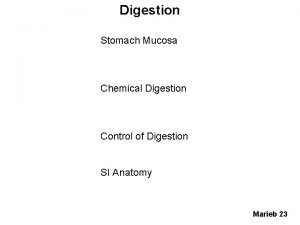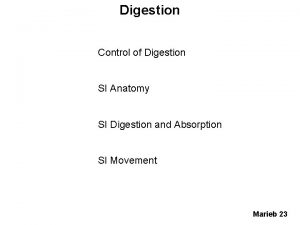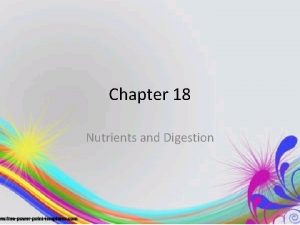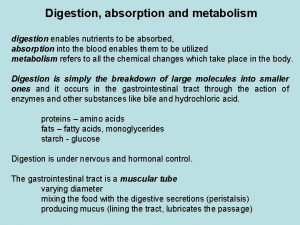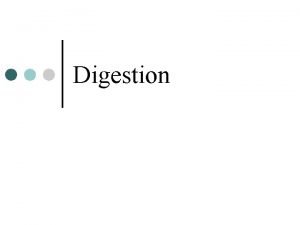Chapter 12 Lesson 1 Nutrients and Digestion Nutrients














- Slides: 14

Chapter 12 Lesson 1 Nutrients and Digestion

• Nutrients Nutrition – Substances in food that provide energy and materials needed by cells. • Your body needs energy for every activity that it performs. How much energy depends on your body mass, age, and activity level. • Six kinds of nutrients are available in food – 1. proteins – 2. carbohydrates – 3. fats – 4. vitamins – 5. minerals – 6. water

• 1. Proteins – Large molecules made of carbon, hydrogen, oxygen, nitrogen, and sometimes sulfur. – MADE UP OF AMINO ACIDS!!! • Your body needs 20 amino acids to make thousands of proteins used in your cells. – 8 essential amino acids- supplied by foods you eat. – YOUR BODY CANNOT MANUFACTURE THE EIGHT ESSENTIAL AMINO ACIDS!

• 2. Carbohydrates – The main source of energy for your body. – Humans should get most of their energy from the carbohydrates they eat. – When carbs are broken down in the presence of oxygen in your cells, this energy is released for use by your body. • Three types of carbs are: sugar, starch, and fiber.

• 3. Fats – Nutrients that provide energy and help the body absorb vitamins. • Good storage unit for energy • Excess energy from the foods you eat is converted to fat and stored for later use. • 4. Vitamins – Organic nutrients needed for growth, regulating body functions, and preventing disease. – Your bone cells need vitamin D to use calcium

• 5 Minerals – Nutrients that lack carbon (inorganic) regulate many chemical reactions in your body. • Calcium and phosphorus are used in largest amounts for a variety of body functions. • 6. Water – Human body is 60% water – Water leaves your body by: • Water vapor • Perspiration – Need 2 L of water a day.

• Foods that contain the same type of nutrient belong to a food group.

The Digestive System • Digestion – The process that breaks down food into small molecules so that they can be absorbed and moved into the blood. • Enzyme – Type of protein that speeds up the rate of a chemical reaction in your body. – Amylase- enzyme produced by glands near mouth • Helps breakdown carbohydrates

Digestive System Organs • Major organs of digestive tract – Mouth, esophagus, stomach, small intestine, large intestine, rectum, and anus • Accessory Organs – Tongue, teeth, salivary glands, liver, gallbladder, and pancreas. • • Food passes through in this order! 1. Tongue, teeth, mouth 2. Esophagus 3. Stomach 4. Small intestine 5. Large intestine 6. Rectum and anus

Digestive System Organs Mouth Esophagus Liver Gallbladder Large Intestine Stomach Pancreas Small Intestine Rectum


• Saliva – Watery substance produced by glands in the mouth. – Begins the breakdown of starch to sugar • Esophagus – Moves food downward by peristalsis with no digestion taking place. • Peristalsis – Wave in esophagus that moves food along digestive system. • Stomach – Produces mucus, which makes food more slippery and protects the stomach from the strong, digestive solutions. – chyme- water liquid that moves from stomach to small intestine.

• The Small Intestine – Absorption of food takes place • Occurs through the walls of fingerlike projections called villi. • VILLI INCREASE THE SURFACE AREA OF THE SMALL INTESTINE. • The duodenum is the 1 st part of the small intestine. • The Large Intestine – Absorbs large amounts of water to help maintain homeostasis in the body. – Muscle contractions in the large intestine are SLOWER than those in the small intestine. – Bacteria helps aid in digestion.

• Pancreas – Produces enzymes and insulin • Liver – Produces bile • Rectum – Releases the solid waste – http: //glencoe. mcgrawhill. com/sites/dl/free/0078617022/161752/00050758. html
 Venn diagram mechanical and chemical digestion
Venn diagram mechanical and chemical digestion Chapter 10 nutrition for health lesson 2 answer key
Chapter 10 nutrition for health lesson 2 answer key Texture repair glencoe
Texture repair glencoe Lesson 11: feeding and digestion
Lesson 11: feeding and digestion Lesson 11: feeding and digestion
Lesson 11: feeding and digestion Digestion and excretion lesson 3
Digestion and excretion lesson 3 Chapter 15 digestion and nutrition
Chapter 15 digestion and nutrition Chapter 5 nutrients at work
Chapter 5 nutrients at work Chapter 1 lesson 1 your total health lesson 1 quiz answers
Chapter 1 lesson 1 your total health lesson 1 quiz answers Passageway of water and nutrients
Passageway of water and nutrients Nutrients and their functions table
Nutrients and their functions table Nutrition objective
Nutrition objective Classification of macronutrients
Classification of macronutrients Nutrients and their functions table
Nutrients and their functions table How is waste and nutrients transported in a cnidarian
How is waste and nutrients transported in a cnidarian
